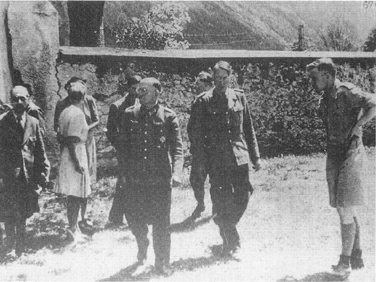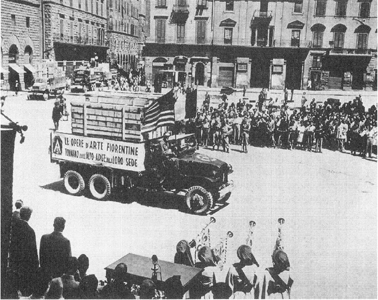The Rape of Europa (51 page)
Read The Rape of Europa Online
Authors: Lynn H. Nicholas
Tags: #History, #Military, #World War II, #Art, #General

By January everyone, Allied, Kunstschutz, Fascist, or otherwise, believed for their various reasons that the treasures, now completely in the control of the SS, were intended for the Führer’s collections. They could not know that the objects had become pawns in the elaborate end game of the war in Italy. The central figure in this shadowy web of events was SS General Wolff himself, whose rank put him second only to Himmler in the Nazi hierarchy.
Wolff had for years been Himmler’s personal assistant and liaison with Hitler and von Ribbentrop, and as such had their trust and total access to the highest circles. The Führer, aware of Wolff’s talents, had sent him to Italy as a quasi governor general who would keep an eye on Mussolini.
As the ultimate defeat of Germany became more and more apparent, Wolff began to think it imperative to open negotiations with the Allies. His first initiatives were conveyed to an American OSS office in Switzerland, headed by Allen Dulles, where they were regarded skeptically, it being well known that Hitler wanted to divide the Allies and try to get the United States and Britain to join him against the Russians. The SS General now had to wait for further opportunities while maintaining his apparent loyalty to the Reich. The works of art were extremely useful in his double game. By refusing to give them to the Italians, and having the album made for Hitler, he made clear that he was saving them for the Führer Reserve.
By refusing to allow them to be removed from within the boundaries of what the Allies considered Italian territory, he demonstrated his good faith in that quarter.
Alexander Langsdorff
(second from right)
showing British MFAA officer J. B. Ward-Perkins the Kunstschutz repositories
Wolff did not hide his negotiations. In an early February meeting he convinced his Commander in Chief that he was indeed promoting Allied dissension. Shaken by Hitler’s physical condition and his adamant refusal to consider an end to the fighting, even after the failure of the Battle of the Bulge, Wolff returned to Italy determined to redouble his efforts. Dulles finally agreed to see him on March 8. To prepare for the meeting, the General had sent ahead a sort of résumé of his career and good deeds in Italy which included, to the amazement of the OSS men, a list of almost all the Florentine works of art they had ever heard of, which Wolff claimed to be able to deliver to them.
61
By April 13 the negotiations had progressed so well that Wolff had even agreed to have an OSS radio operator installed in his headquarters in order to facilitate communications.
But the Allied High Command, determined to pursue an unconditional surrender to the bitter end, obsessed with the idea of a Bavarian Redoubt, and accused by Stalin of bad faith for these separate negotiations, on April
20 ordered the OSS to break off all contact. This was extremely awkward. Before Dulles could inform Wolff he discovered that the SS General and representatives of the Wehrmacht, whom he had persuaded with great effort to join him, had already arrived in Switzerland prepared to sign a surrender. While Dulles radioed Supreme Headquarters in Caserta hoping for a change in policy, Wolff received yet another exhortation from Hitler, ordering his armies to hold out at all costs. Wolff realized that he must return to his headquarters in order to prevent chaos, but the other members of his party stayed behind. Before he left, he handed Dulles a handwritten note indicating the locations of the Florentine treasures and advised him to send Army units to protect them from plunder. Four days later the Allies reversed their policy, and the German officers were flown to Caserta, where in absolute secrecy they signed the surrender of Italy, which was announced to the world on May 2.
62
Within days Monuments officers and Italian Fine Arts personnel were on their way to the Brenner Pass. Here on the borders of the Reich the world seemed upside down: in Bolzano, Germans of “colossal arrogance,” not yet confined to POW camps, outnumbered the victors ten to one and were living and feasting happily in the best hotels while the Americans camped miserably in tents and “the Military Government Provincial Commissioner had to plod about the town on foot, hot, red faced and dusty, while haughty and glittering SS Generals sped past in motor cars loaded with blondes.”
63
Dulles’s assistant, Gero von Gaevernitz, invited to see Wolff a week later, found much the same scene: the German Army “enjoying springtime in the Alps … consuming their remaining supplies of food and drink. … It was a peaceful scene, rather like lunchtime at the M-G-M studios.” He too had trouble getting a hotel room away from the conquered, and was received in great style at Wolff’s headquarters in the Palace of the Dukes of Pistoia. Farther up the road to the Brenner the Monuments men found no Americans at all. The countryside seemed entirely in the power of heavily armed Germans.
64
But it was worth the trip: in the narrow jail cells at San Leonardo there they all were, without cases and squeezed dangerously together: Titian’s
Philip II
, Caravaggio’s
Bacchus
, the great Bellini
Pietà
, and, modestly hidden under an old bedspread, Cranach’s
Adam
and
Eve.
At Campo Tures, or “Neumelans,” Langsdorff impatiently awaited them. Here a number of pictures were packed in cases newly labelled “Kunstwerke aus Italienischen Staatsbesitz.” Reidemeister and Langsdorff, brought down to earth during frequent interrogations administered by British Wing Commander Douglas Cooper, collector and art historian turned specialist Intelligence officer, and by the unglamorous life in the
POW enclosures, cooperated fully. After the inventories and lists were checked, all but ten works, which included a pair of tiny and extraordinarily valuable paintings by Pollaiuolo depicting the Labors of Hercules, were accounted for.
Fifth Army brings the Florentine treasures home.
The public relations importance of this recovery was enormous, and Fifth Army—and anyone else who could get into the act—threw themselves into the arrangements for the return of the treasures with gusto. A heavy guard was posted around the buildings. The Italian Resistance found packers. Fifth Army Commander Lucien Truscott’s personal plane was sent for fire extinguishers. It was a big operation, and there was no little pride involved:
The day the Germans took stuff to the jail at San Leonardo it was raining. The trucks were open and old, the pictures were covered with a few blankets and resting on loose straw. U.S. Army, it is hoped, will do a bang up job just the opposite of this.
65
A train was made up of thirteen freight cars, some with special doors, interspersed with guards’ vans. Special cranes lifted the sculptures. On went Michelangelo’s
Bacchus
and Donatello’s
St. George.
Everyone was very nervous: the priceless shipment, listed simply on the waybill as “Art Treasures,” was valued even then at $500 million.
In Florence a batch of crates were unloaded onto beflagged trucks and, escorted by two jeeploads of curators and Monuments officers, paraded through the hot streets with a sign reading simply,
“Le opere d’arte fiorentine tornano dall’ Alto Adige alla loro sede
[The art works of Florence return from the Alto Adige to their home].” In the shade of the packed Piazza della Signoria, Fifth Army General Edgar E. Hume officially gave the cases to the mayor of Florence. “A spontaneous ovation was given the General by weeping and emotionally touched citizens,” Keller later reported. Hartt was overcome by the “sincerity and spontaneity of the population,” who crowded around General Hume, “embracing him, weeping with joy, striving to touch his uniform.” The war seemed really over. Later, the ever-practical Keller noted, “a good banquet followed.”
66
Within weeks of these festive events the Monuments officers in Italy found their jobs had come to an end. Disappointed and frustrated at having to leave many of their projects unfinished, they were moved on. It would be up to the Italians themselves to complete the job. To one man in particular it seemed far from finished: Rodolfo Siviero, mysterious member of the Italian Resistance, who had been collecting tidbits of art-related intelligence for years, was not satisfied with the return of the national collections alone. Much from Italy had been confiscated and been sold or given to the Nazi hierarchy. Siviero felt that all these objects should return to Italy. He would find that many did not agree.
X
TOUCH AND GO
The Allies Take Over:
Northern Europe, 1944–1945
I cannot resist the temptation to recount the efforts made to save my treasures. It illustrates how little planning and plotting mattered; how much it was touch and go.
—Bernard Berenson,
Rumor and Reflection
October 1944
Immediately after Roosevelt and Churchill had decided on the invasion of Northern Europe in August 1943, the Joint Military Staffs had begun to discuss strategy for the event. The shadows of World War I affected both camps. To the Americans the proper place for fighting Germany was not Italy or Africa, but the north of France. The British, remembering the terrible attrition of trench warfare in Flanders, were reluctant to enter this territory again. But at the Teheran Conference in early December, with pressure from Stalin, who had long wanted a second front, the invasion policy was reaffirmed. Roosevelt informed Eisenhower of his appointment as Supreme Allied Commander on the way back from the Conference.
Now Eisenhower was where he had always wanted to be. The excitement of the coming campaign in France was all-encompassing. The American leaders envisioned a swift withdrawal of forces from the European theater for possible redeployment in the Far East after the inevitable Allied victory, which, they felt sure, would take place in 1944. The occupied nations would revert to the control of their duly elected governments and Germany would be punished so that it could never burst forth again. Just exactly how all this was to be effected remained to be determined, although plenty of people had very strong ideas on the subject.
To Lieutenant Colonel Sir Leonard Woolley in London it was quite clear from events in Italy that there was no time to waste on preparations for the European invasion, even though no one yet knew exactly when that would take place. He appointed the Slade Professor of Fine Arts at Cambridge, Geoffrey Webb, to direct Monuments operations for SHAEF (Supreme Headquarters, Allied Expeditionary Force), as Eisenhower’s headquarters were known, and brought in an American officer, Calvin Hathaway of the Cooper Union Museum, to assist. Together, in December, they drew up the first draft of the directives which would be given to Monuments officers in the European theater.
1
They proposed that a lieutenant colonel and two majors head the operation and particularly insisted that officers in the field not only be concerned with the protection of buildings and the prevention of looting but with “evidence … of theft by the Germans … with a view to subsequent compensation or restitution under the terms of the peace settlement.” They included a clause requiring that reports be sent directly to the Roberts Commission once a month as well as to Civil Affairs headquarters in London.
Other books
Mist and Shadows: Short Tales From Dark Haunts by Yasmine Galenorn
Ghost King by Gemmell, David
Once Upon an Accident 01 - The Accidental Countess by Melissa Schroeder
Midnight's Children by Salman Rushdie
Urges: Part Three (The Urges Series Book 3) by Corgan, Sky
God is in the Pancakes by Robin Epstein
My Teacher is a Zombie (Supernatural Learning Book 1) by Murdock, J.R.
Judith Wants To Be Your Friend by Annie Weir
Her Lord and Master by Alexa Cole
An Unnatural Daughter: A Dark Regency Mystery by Katherine Holt



